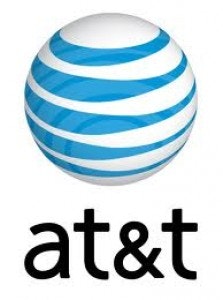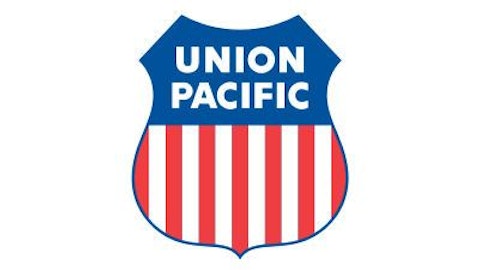How many times have you heard of a company with 100 million subscribers struggling to maintain its relevance? You could make the argument that AT&T Inc. (NYSE:T) is playing second fiddle to Verizon Communications Inc. (NYSE:VZ). Verizon Communications Inc. (NYSE:VZ) has been able to play up the company’s wireless network and Big Red’s subscriber additions have been much stronger than AT&T Inc. (NYSE:T)’s. However, AT&T Inc. (NYSE:T) is doing many things right and investors should be encouraged by recent results.
Competitive pressure from all sides
While it’s true that AT&T Inc. (NYSE:T) owns its whole wireless business, while Verizon Communications Inc. (NYSE:VZ) only owns 55%, that is about to change. With Verizon Communications Inc. (NYSE:VZ) reportedly buying the remainder of Verizon Wireless from Vodafone, AT&T Inc. (NYSE:T) will face a different opponent than before. Without the requirement to pay dividends to Vodafone, Verizon Communications Inc. (NYSE:VZ) will be able to plow that extra cash flow into the business, service debt, or return to shareholders.
While Verizon Communications Inc. (NYSE:VZ) is probably the most notable competitor to AT&T Inc. (NYSE:T), investors can’t ignore the competitive pressure being applied by local telecommunications companies like Windstream Holdings Inc (NASDAQ:WIN). Windstream Holdings Inc (NASDAQ:WIN) and others are trying to offset their traditional voice losses with high-speed Internet additions and new video subscribers. Since AT&T is also trying to grow subscribers in these areas, the company faces challenges from all sides.
Room for improvement
The first reason investors should like AT&T’s recent results is the company’s wireless margin may show improvement going forward. The company’s wireless unit sports over 100 million subscribers, which is nearly equivalent to Verizon Wireless’ subscriber count. However, Verizon’s unit carries an operating margin of 32.4%, whereas AT&T’s division has a margin of 27.1%.
One reason AT&T’s margin might be lower is the company’s level of smartphone subscribers is higher at 73% of postpaid subscribers versus 64% at Verizon. However, AT&T seems to be gaining tablet users at a faster rate than Verizon. In the current quarter, AT&T added 551,000 postpaid subscribers versus 941,000 at Verizon. The difference is AT&T said that they added 398,000 tablet subscribers. Since tablet users require a data plan, yet don’t require a large subsidy like smartphones, if this keeps up AT&T’s margin could improve.
Strength in the face of competition
The second reason investors should consider AT&T is the company’s strong high-speed Internet additions. In the current quarter, AT&T added 7.04% more high-speed Internet subscribers, whereas Windstream Holdings Inc (NASDAQ:WIN) actually witnessed a decline of 1%. While Verizon added 12.2% more Internet subscribers, there was one big difference between the three companies.
Verizon grew high-speed subscribers at a faster rate, but the company reported a net loss in the wireline business for the quarter. Windstream Holdings Inc (NASDAQ:WIN) reported a 33% decline in EPS, while AT&T reported that wireline operating profit was down 15.8%, but $1.6 billion for the quarter. As you can see, other companies might grow faster or slower, but AT&T turned in the best profit performance.
These two reasons are obvious
Two of the most obvious reasons for investors to consider AT&T are well known and easy to recognize. First, AT&T has the best sustainable yield among the group. Verizon’s yield of 4.53% is lower than AT&T’s at 5.27%. While Windstream Holdings Inc (NASDAQ:WIN)’s yield of more than 12% would seem to be the best, it is far from sustainable.
If you look at the core cash flow (net income + depreciation – capital expenditures) of each company, AT&T has a reasonable payout ratio of 69.55% over the last six months. While this might seem a bit high, if the company can improve its wireless margins, this ratio should decrease from the extra cash flow. While Verizon’s payout ratio was just 27.52%, Windstream Holdings Inc (NASDAQ:WIN)’s ratio is much worse at 103.35%.
The second reason AT&T should be attractive, is AT&T’s commitment to retiring shares. The company retired 8.2% of their diluted shares in the last year. By comparison, Verizon and Windstream both saw their share count increase slightly.
When you get right down to it, AT&T offers a good yield and prospects for better growth and cash flow in the future. While Verizon is expected to grow faster, the company’s $130 billion acquisition of Verizon Wireless is likely to keep a lid on some of that growth. Unfortunately, Windstream’s debt-to-equity ratio of 9.37 makes the company a risky bet no matter how high the yield. As you can see, AT&T’s shareholders have nothing to feel blue about.
The article 4 Reasons Investors Shouldn’t Feel Blue After These Results originally appeared on Fool.com is written by Chad Henage.
Chad Henage owns shares of Verizon Communications (NYSE:VZ). The Motley Fool has no position in any of the stocks mentioned.
Copyright © 1995 – 2013 The Motley Fool, LLC. All rights reserved. The Motley Fool has a disclosure policy.






